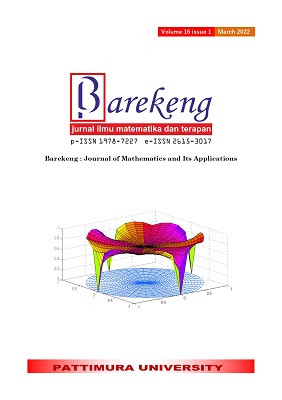CLASSIFICATION SUPPORT VECTOR MACHINE IN BREAST CANCER PATIENTS
Abstract
Support vector machine is one of the supervised learning methods in machine learning that is used in classification. The purpose of this study is to measure the accuracy of classification by using 3 hyperplane functions in SVM, namely linear, sigmoid, polynomial, and radial basis function (RBF). Based on the simulation results of training data and testing data on female breast cancer patients, SVM with hyperplane RBF has better accuracy than hyperplane polynomial, linear and sigmoid. The RBF results for the training and testing data were 89.1% and 73.2%, respectively. Based on the results of the classification of training data for female breast cancer patients, 88.07% had no recurrence and 93.33% had recurrence events. Meanwhile, based on the results of the classification of testing data, female patients did not recurrence events and recurrence events was 72.55% and 80.00%, respectively. So from this article, it can be concluded that SVM with hyperplane RBF is one of the best methods in the application of the method of classifying female breast cancer patients.
Downloads
References
National Cancer Institute, Breast Changes. National Institutes of Health (NIH), 2014.
D. Roganovic, D. Djilas, S. Vujnovic, D. Pavic, and D. Stojanov, “Breast MRI, digital mammography and breast tomosynthesis: Comparison of three methods for early detection of breast cancer,” Bosn. J. Basic Med. Sci., vol. 15, no. 4, pp. 64–68, 2015, doi: 10.17305/bjbms.2015.616.
T. A. S. O. B. Surgeons, “Consensus Guideline on Diagnostic and Screening Magnetic Resonance Imaging of the Breast,” Am. Soc. Breast Surg., pp. 76–99, 2017.
P. S. K. K. S. Sharma, Ganesh N. Rahul Dave, Jyotsana Sanadya, “Various Types and Management of Breast Cancer: An Overview,” J. Adv. Pharm. Tech. Res., vol. 1, no. 2, pp. 109–126, 2010.
N. F. Idris and M. A. Ismail, “Breast cancer disease classification using fuzzy-ID3 algorithm with FUZZYDBD method: Automatic fuzzy database definition,” PeerJ Comput. Sci., vol. 7, pp. 1–22, 2021, doi: 10.7717/PEERJ-CS.427.
UCI Machine Learning, “UC Irvine Machine Learning Repository.” archive.ics.uci.edu (accessed Sep. 08, 2021).
A. Krysovatyy, H. Lipyanina-Goncharenko, S. Sachenko, and O. Desyatnyuk, “Economic crime detection using support vector machine classification,” CEUR Workshop Proc., vol. 2917, pp. 830–840, 2021.
A. Jahangiri, “Developing a Support Vector Machine (SVM) Classifier for Transportation Mode Identification by Using Mobile Phone Sensor Data Collaborative Optimization and Planning for Transportation Energy Reduction View project,” no. February, 2014, [Online]. Available: https://www.researchgate.net/publication/270959050.
N. Naw and A. C. Mon, “Social media data analysis in sentiment level by using support vector machine,” J. Pharmacogn. Phytochem., vol. 7, no. 1S, pp. 609–613, 2018.
J. I. Daoud, “Multicollinearity and Regression Analysis,” J. Phys. Conf. Ser., vol. 949, no. 1, 2018, doi: 10.1088/1742-6596/949/1/012009.
J. H. Kim, “Multicollinearity and misleading statistical results,” Korean J. Anesthesiol., vol. 72, no. 6, pp. 558–569, 2019, [Online]. Available: https://stat.duke.edu/~kfl5/Lock_RREE_Results_2010.pdf.
N. Herawati, K. Nisa, and E. Setiawan, “Regularized Multiple Regression Methods to Deal with Severe multicolinearity,” vol. 8, no. May 2018, pp. 167–172, 2018, doi: 10.5923/j.statistics.20180804.02.
M. Awad and R. Khanna, Efficient learning machines: Theories, concepts, and applications for engineers and system designers, no. May 2016. 2015.
S. Hasanah and S. Permatasari, “Metode Klasifikasi Jaringan Syaraf Tiruan Backpropagation Pada Mahasiswa Statistika Universitas Terbuka,” BAREKENG J. Ilmu Mat. dan Terap., vol. 14, no. 2, pp. 243–252, 2020, doi: 10.30598/barekengvol14iss2pp249-258.
J. Novakovic, A. Veljovi, S. Iiic, Z. Papic, and M. Tomovic, “Evaluation of Classification Models in Machine Learning,” Theory Appl. Math. Comput. Sci., vol. 7, no. 1, pp. 39–46, 2017, [Online]. Available: https://uav.ro/applications/se/journal/index.php/TAMCS/article/view/158.
A. Baratloo, M. Hosseini, A. Negida, and G. El Ashal, “Part 1: Simple Definition and Calculation of Accuracy, Sensitivity and Specificity.,” Emerg. (Tehran, Iran), vol. 3, no. 2, pp. 48–9, 2015, doi: 10.22037/emergency.v3i2.8154.
Authors who publish with this Journal agree to the following terms:
- Author retain copyright and grant the journal right of first publication with the work simultaneously licensed under a creative commons attribution license that allow others to share the work within an acknowledgement of the work’s authorship and initial publication of this journal.
- Authors are able to enter into separate, additional contractual arrangement for the non-exclusive distribution of the journal’s published version of the work (e.g. acknowledgement of its initial publication in this journal).
- Authors are permitted and encouraged to post their work online (e.g. in institutional repositories or on their websites) prior to and during the submission process, as it can lead to productive exchanges, as well as earlier and greater citation of published works.






1.gif)



